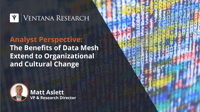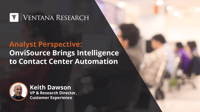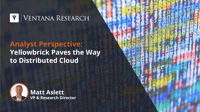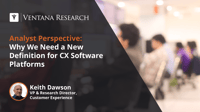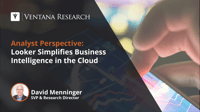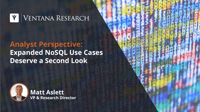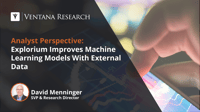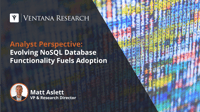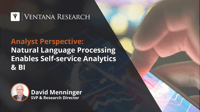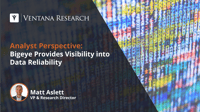Ventana Research is happy to share insights gleaned from the latest Value Index research, an assessment of how well vendors’ offerings meet buyers’ requirements. The 2022 Revenue Performance Management (RPM) Value Index is the distillation of a year of market and product research. Drawing on our Benchmark Research, we apply a structured methodology built on evaluation categories that reflect the real-world criteria incorporated in a request for proposal to vendors supporting the spectrum of...
Read More
Topics:
Sales,
Sales Performance Management (SPM),
Price and Revenue Management,
sales enablement,
Revenue Performance Management
I have written previously that the world of data and analytics will become more and more centered around real-time, streaming data. Data is created constantly and increasingly is being collected simultaneously. Technology advances now enable organizations to process and analyze information as it is being collected to respond in real time to opportunities and threats. Not all use cases require real-time analysis and response, but many do, including multiple use cases that can improve customer...
Read More
Topics:
business intelligence,
Analytics,
Internet of Things,
Data,
Digital Technology,
Streaming Analytics,
AI & Machine Learning,
Analytics & Data,
Streaming Data & Events
As organizations shift focus to a broader definition of sales that includes all sources of revenue, vendors are also pivoting to include “revenue” as part of promotional messaging. But it’s my view that just changing your message or description does not necessarily deliver the capabilities and product experiences customers need to successfully plan, execute and achieve revenue targets and objectives. The just-completed 2022 Ventana Research Value Index for Revenue Performance Management...
Read More
Topics:
Revenue Management,
Revenue Performance Management
The term "corporate spend" usually refers to the incidental but still significant outlays organizations make to support operations. Especially in nonmanufacturing industries, purchases of indirect goods and business services – such as computers, office supplies, furniture and services – as well as travel and entertainment can represent a significant percentage of total costs. Technology has evolved to the point where executives – especially the chief financial officer – need to take an...
Read More
Topics:
ERP,
Financial Performance Management (FPM),
digital finance
Data mesh is the latest trend to grip the data and analytics sector. The term has been rapidly adopted by numerous vendors — as well as a growing number of organizations —as a means of embracing distributed data processing. Understanding and adopting data mesh remains a challenge, however. Data mesh is not a product that can be acquired, or even a technical architecture that can be built. It is an organizational and cultural approach to data ownership, access and governance. Adopting data mesh...
Read More
Topics:
Analytics,
Business Intelligence,
Data Governance,
Data Integration,
Data,
Digital Technology,
Digital transformation,
data lakes,
data operations,
Digital Business,
data platforms,
Analytics & Data,
Streaming Data & Events
Ventana Research defines subscription management as the processes and technology needed to manage the subscriber experience from the first digital touch to the continuous modifications of orders for services and billing. Effective subscription management requires a new generation of applications designed to manage the life cycle of subscriptions and provide subscribers with the experiences they expect. The subscription business model has grown in popularity across many industries, and for many...
Read More
Topics:
Subscription Management,
Revenue Management
Today’s contact center agents find themselves handling increasingly more complex interactions due to changes in consumer demand, advances in self-service and the proliferation of digital contact channels. This added complexity requires continuous agent support for successful customer experience outcomes. Intelligent software can reduce agent workload and improve customer interactions by picking up customer cues.
Read More
Topics:
Customer Experience,
Contact Center,
AI
For years, maybe decades, we have heard about the struggles between IT and line-of-business functions. In this perspective, we will look at some of the data from our Analytics and Data Benchmark Research about the roles of IT and line-of-business teams in analytics and data processes. We will also look at some of the disconnects between these two groups. And, by looking at how organizations are operating today and the results they are achieving, we can discern some of the best practices for...
Read More
Topics:
Analytics,
Business Intelligence,
Data,
Digital Technology,
AI & Machine Learning,
Analytics & Data
Ventana Research recently published the results of our Business Planning Value Index Research and I commented on its connection to our emphasis on using software to unify planning processes across an enterprise to improve performance. Since 2007, we have advocated what we call Integrated Business Planning (IBP): a high-participation, collaborative, action-oriented approach to planning and budgeting built on frequent, short planning sprints. Short planning cycles enable companies to achieve...
Read More
Topics:
Business Planning,
digital finance,
Finance Performance Management
Despite widespread and increasing use of the cloud for data and analytics workloads, it has become clear in recent years that, for most organizations, a proportion of data-processing workloads will remain on-premises in centralized data centers or distributed-edge processing infrastructure. As we recently noted, as compute and storage are distributed across a hybrid and multi-cloud architecture, so, too, is the data it stores and relies upon. This presents challenges for organizations to...
Read More
Topics:
Analytics,
Business Intelligence,
Data Governance,
Data,
data operations,
AI & Machine Learning,
data platforms
Digital Transformation. The Subscription Economy. Omni-Channel Selling. Customer Centric. These are all terms used to label trends and events that are changing the way business is being conducted, a change that has accelerated due to recent events. Regardless of the terminology, there is no doubt that the way vendors and buyers are interacting, whether B2C or B2B, is different today for many organizations than it was even five years ago. But to be fair, no technology on its own can transform...
Read More
Topics:
Sales,
Digital Commerce,
Subscription Management,
partner management,
Revenue Management
The technology underpinning customer experience (CX) is a hodgepodge of tools that have been developed for niche use cases and then expanded to fill broader roles. Examples include the old (CRM, help desk software and speech analytics) and the new (customer data platforms and conversational AI). This is because CX is a set of very specialized processes that happen in different parts of the enterprise, managed by people who often do not connect with peers handling related processes....
Read More
Topics:
Customer Experience,
Marketing,
Marketing Performance Management,
Voice of the Customer,
Contact Center,
Product Information Management,
Digital Marketing,
agent management,
intelligent marketing,
Customer Experience Management,
Digital Experience Platform,
Conversational Marketing,
customer service and support
Organizations face various challenges with analytics and business intelligence processes, including data curation and modeling across disparate sources and data warehouses, maintaining data quality and ensuring security and governance. Traditional processes are slow when transforming large and diverse datasets into something which is easily consumable in BI. And, it can take days or weeks to create reports and dashboards — maybe longer if processes change and new data sources are introduced....
Read More
Topics:
Big Data,
Analytics,
Business Intelligence,
Cloud
Value-added tax is a type of levy that is applied at each step of a transaction chain, from basic inputs to the final good or service. The amount assessed is based on the value added by an organization (hence the name) when a transaction occurs. VAT is used throughout the world because, historically, it has been harder to evade compared to income taxes. VAT is a common method of national taxation: Approximately 85% of countries impose it worldwide. A notable exception is the United States,...
Read More
Topics:
Office of Finance,
Tax,
VAT
I recently examined how evolving functionality had fueled the adoption of NoSQL databases, recommending that organizations evaluate NoSQL databases when assessing options for data transformation and modernization efforts. This recommendation was based on the breadth and depth of functionality offered by NoSQL database providers today, which has expanded the range of use cases for which NoSQL databases are potentially viable. There remain a significant number of organizations that have not...
Read More
Topics:
NoSQL,
Data,
data platforms,
Use Cases
Today, organizations understand the importance of good external data that can be integrated with internal data to train machine learning models. Our Machine Learning Dynamic Insights research showed that external data adds a significant value in gaining competitive advantage, improving customer experience and increasing sales. But getting the right external data for a particular requirement is not always easy. Internal data is usually not enough to train different models because of its narrow...
Read More
Topics:
Explorium,
External Data Platform
I recently attended an analyst conference held by Unit4, an enterprise resource planning vendor focused on midsize organizations in people-centric industries. The conference was intended to communicate the company’s strategy, product updates and roadmap. The meeting took place shortly after announcement of the availability of Unit4 Industry Mesh and the acquisition of Compright, which does compensation planning as well as in the context of the broad technology shifts affecting ERP applications.
Read More
Topics:
Human Capital Management,
Office of Finance,
Business Planning,
Talent Management,
Financial Performance Management,
ERP and Continuous Accounting,
Total Compensation Management,
digital finance
The various NoSQL databases have become a staple of the data platforms landscape since the term entered the IT industry lexicon in 2009 to describe a new generation of non-relational databases. While NoSQL began as a ragtag collection of loosely affiliated, open-source database projects, several commercial NoSQL database providers are now established as credible alternatives to the various relational database providers, while all the major cloud providers and relational database giants now also...
Read More
Topics:
Analytics,
Data,
AI & Machine Learning,
data platforms
Software that automates the full scope of the accounting close, including reconciliations, consolidation and reporting, has grown more capable and affordable over the past five years. By enabling consistent process management that captures best practices, and by automating rote, repetitive activities to boost staff productivity, these applications enable organizations to shorten the close, make the process more efficient and reduce the risk of material errors by strengthening accounting...
Read More
Topics:
Office of Finance,
Financial Performance Management (FPM),
ERP and Continuous Accounting,
digital finance
Natural language processing (NLP) is a field that combines artificial intelligence (AI), data science and linguistics that enables computers to understand, interpret and manipulate text or spoken words. NLP includes generating narratives based on a set of data values, using text or speech as inputs to access information, and analysing text or speech, for instance, to determine its sentiment. There are various techniques for interpreting human language, ranging from statistical and machine...
Read More
Topics:
Big Data,
Analytics,
natural language processing,
NLP
As businesses become more data-driven, they are increasingly dependent on the quality of their data and the reliability of their data pipelines. Making decisions based on data does not guarantee success, especially if the business cannot ensure that the data is accurate and trustworthy. While there is potential value in capturing all data — good or bad — making decisions based on low-quality data may do more harm than good.
Read More
Topics:
Data Governance,
Data Integration,
Data,
Digital Technology,
data lakes,
data operations,
Analytics & Data
In a previous Analyst Perspective, we discussed some of the big-picture trends that are bringing cost control back as a core driver of contact center operations. In this report we will tackle some of the practical ramifications: how those trends affect decision-making and operations.
Read More
Topics:
Customer Experience,
Voice of the Customer,
Contact Center,
agent management,
Customer Experience Management,
Field Service,
customer service and support




